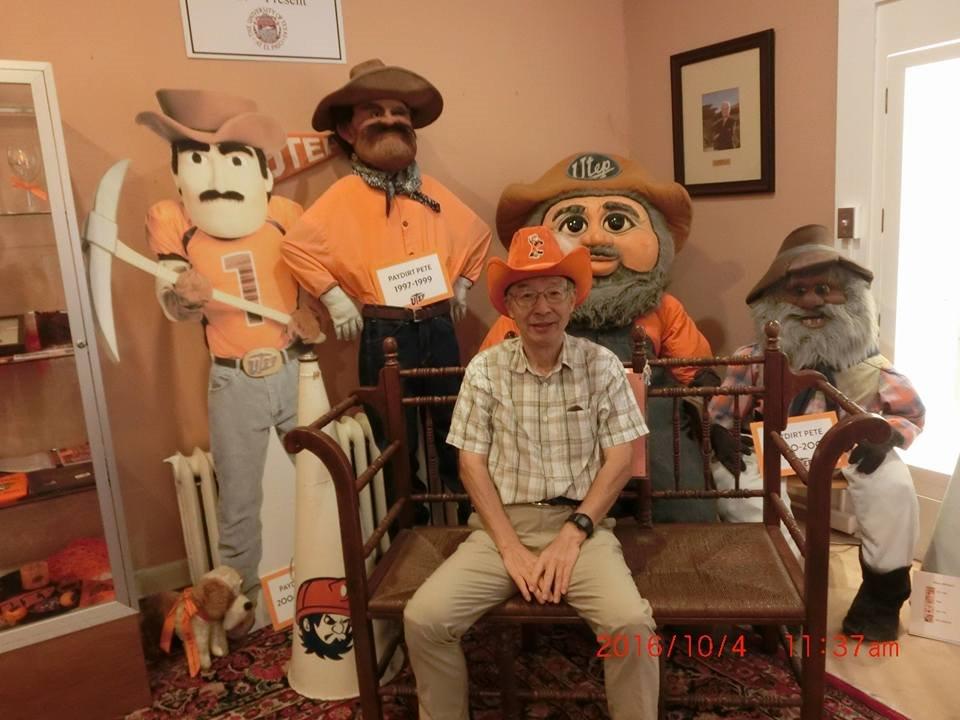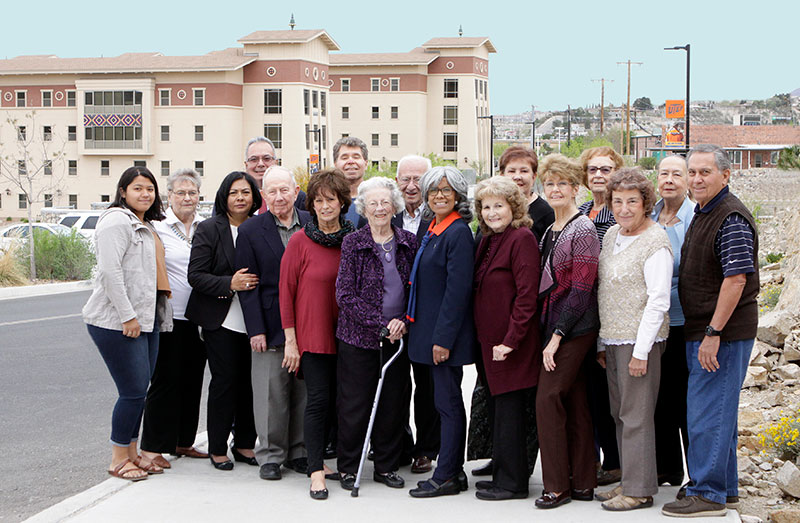UTEP's Heritage House Shines Light on Institution's Past
Last Updated on April 16, 2018 at 12:00 AM
Originally published April 16, 2018
By Daniel Perez
UTEP Communications
With all the hustle and bustle of college life, it is understandable if students, faculty and staff at The University of Texas at El Paso ignore the nondescript two-story, sand-colored stucco building “hidden” in the center of campus. Understandable, but unfortunate.

The building in question is Heritage House, 405 Kerbey Ave. It has served many purposes through the years from home to classroom to gallery. It is a valued depository of artifacts and memorabilia that chronicles and celebrates UTEP’s existence and traditions starting from its days as the State School of Mines and Metallurgy in 1914.
The wall-to-wall displays and special exhibits overseen by UTEP’s Heritage Commission can educate about the campus’ past or elicit warm waves of nostalgia.
For Ramiro Martinez, a retired El Paso pharmacist who earned his bachelor’s degree in chemistry from UTEP in 1967, it was a little of both. He found himself sitting in the Heritage Conference Room, the former home’s dining area, lost in the past as he fingered through an old Flowsheet yearbook.
Martinez said he passed the Heritage House as a student, but never gave the building much thought. At that time, the converted home was used for special University projects.
While on campus for 2017 Homecoming activities, someone recommended he visit the house. One hour into his tour, he was having a pseudo-reunion because he found several of his college buddies on the black-and-white pages of the Flowsheet.
“(Heritage House) is very nice,” said Martinez, who was appointed to the Heritage Commission in November 2017 because of his interest. “It’s nice to come back and see how things were. There’s a lot of history here.”
The home houses collections of books, photos, uniforms, sculptures, paintings and assemblies of glassware, jewelry and different incarnations of UTEP mascot Paydirt Pete. The Heritage Commission has an inventory of thousands of artifacts, which includes approximately 2,000 glossy, black-and-white photos of the campus, people on campus and campus activities throughout the years.
Built in 1920, the building served as home to the institution’s first dean, Steve H. Worrell, and his wife, Kathleen. The Worrells deeded the home to the college after they left in 1923. It remained a residence until the 1960s when it was used as a classroom, for special projects, and eventually for facilities services. University President Diana Natalicio approved renovations to the property and turned it over to the Heritage Commission in 1994.
UTEP formally created the 30-member Heritage Commission on Oct. 8, 1980, to preserve the University’s artifacts. The all-volunteer group is made up mostly of retired alumni, faculty and staff. Before Heritage House, members kept memorabilia in their offices and in the basement of the Administration Building.

UTEP's Heritage Commission, pictured during a spring 2018 meeting near Miner Canyon student housing, oversees the research and displays at Heritage House. Photo: Laura Trejo / UTEP Communications
Commission members inventory donations, respond to research inquiries and set up displays in Heritage House and the glass display case outside the Tomás Rivera Conference Center on the third floor of Union Building East. They also lead tours mostly for interested alumni and student groups. The main draw for the hundreds of annual visitors is to learn about the campus’ history, heritage and traditions.
Briane Carter, Heritage Commission chair and former director of UTEP’s University Career Center, did not mince words when discussing the importance of Heritage House.
“If (Heritage House) wasn’t here, the history of UTEP would be lost,” Carter said. “We’re here to preserve that history and allow visitors to rediscover it.”
One of her favorite Heritage House stories involves Tatsumi Morizuka, a retired resident of Kawai-Cho, Japan, who stopped by UTEP during a bus and train tour of the southern United States in 2016.
Morizuka was familiar with California and some Northeastern states, but wanted to experience the Southwest, especially UTEP, which he read about in a Japanese guide book. He praised the campus in general, and was specifically glad to have spent time in Heritage House. He said the photos and exhibits were wonderful ways to familiarize first-time visitors with the University’s history and traditions.
“The time I spent at Heritage House was precious and unique,” Morizuka said in an email interview, adding that he did not know of any similar gallery at a Japanese university. “It is as if I had been transported to a small, fancy land.”
Stephanie Meyers, DMA, professor of music, said the house is a “big hit” with participants of her String Project, a program that offers string instrument instruction to area elementary school students. She said the children are especially fond of the different Paydirt Pete costumes, some of which date back to before their parents were born.
“They see (Heritage House) as a warm, inviting place,” Meyers said. “They love everything about it.”
The C.L. Sonnichsen Special Collections Department in the University Library often collaborates with Heritage House, said Claudia Rivers, director of Special Collections and a de facto member of the Heritage Commission.
The two entities have similar, but different, missions. Whereas Heritage House collects and displays UTEP artifacts, Special Collections is a cache of documents about the University and beyond to include the City of El Paso, the Southwest region and the U.S.-Mexico border.
“We work closely with them,” Rivers said. “They are a wonderful resource. There are a lot of knowledgeable people there who perform a great service for the University.”
Maribel Villalva, assistant vice president for alumni relations, praised the Heritage Commission for the countless hours they spend archiving, caring for and displaying the memorabilia, and then educating the public about the University. The commission and Heritage House are supported by UTEP’s Office of Alumni Relations.
“We are so grateful for these dedicated volunteers who have chosen to give back to UTEP in this meaningful way,” Villalva said. “They help us to preserve UTEP’s proud history.”
For more information about Heritage House, visit www.alumni.utep.edu/heritage.